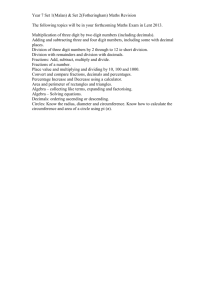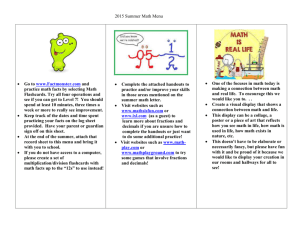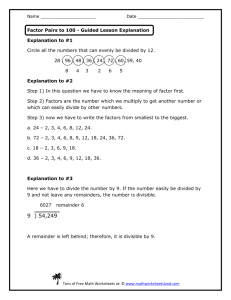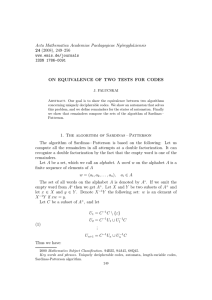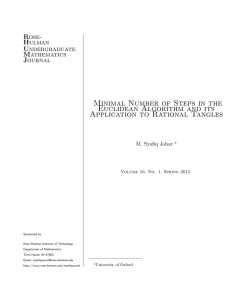MD - Stage 3 - Plan 7 - Glenmore Park Learning Alliance
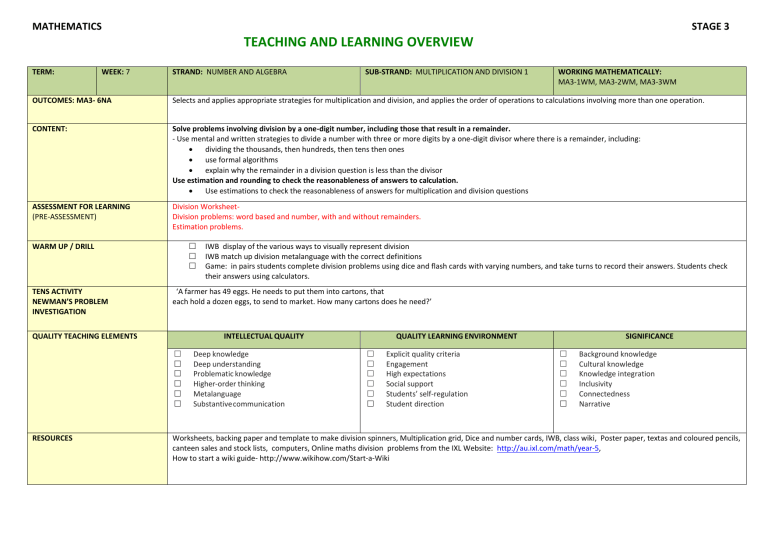
MATHEMATICS
TERM: WEEK: 7
OUTCOMES: MA3- 6NA
CONTENT:
ASSESSMENT FOR LEARNING
(PRE-ASSESSMENT)
WARM UP / DRILL
STAGE 3
TEACHING AND LEARNING OVERVIEW
STRAND: NUMBER AND ALGEBRA SUB-STRAND: MULTIPLICATION AND DIVISION 1 WORKING MATHEMATICALLY:
MA3-1WM, MA3-2WM, MA3-3WM
Selects and applies appropriate strategies for multiplication and division, and applies the order of operations to calculations involving more than one operation.
Solve problems involving division by a one-digit number, including those that result in a remainder.
- Use mental and written strategies to divide a number with three or more digits by a one-digit divisor where there is a remainder, including:
dividing the thousands, then hundreds, then tens then ones
use formal algorithms
explain why the remainder in a division question is less than the divisor
Use estimation and rounding to check the reasonableness of answers to calculation.
Use estimations to check the reasonableness of answers for multiplication and division questions
Division Worksheet-
Division problems: word based and number, with and without remainders.
Estimation problems.
IWB display of the various ways to visually represent division
IWB match up division metalanguage with the correct definitions
Game: in pairs students complete division problems using dice and flash cards with varying numbers, and take turns to record their answers. Students check their answers using calculators.
‘A farmer has 49 eggs. He needs to put them into cartons, that each hold a dozen eggs, to send to market. How many cartons does he need?’
TENS ACTIVITY
NEWMAN’S PROBLEM
INVESTIGATION
QUALITY TEACHING ELEMENTS
RESOURCES
INTELLECTUAL QUALITY
Deep knowledge
Deep understanding
Problematic knowledge
Higher-order thinking
Metalanguage
Substantive communication
QUALITY LEARNING ENVIRONMENT
Explicit quality criteria
Engagement
High expectations
Social support
Students’ self-regulation
Student direction
SIGNIFICANCE
Background knowledge
Cultural knowledge
Knowledge integration
Inclusivity
Connectedness
Narrative
Worksheets, backing paper and template to make division spinners, Multiplication grid, Dice and number cards, IWB, class wiki, Poster paper, textas and coloured pencils, canteen sales and stock lists, computers, Online maths division problems from the IXL Website: http://au.ixl.com/math/year-5 ,
How to start a wiki guide- http://www.wikihow.com/Start-a-Wiki
WHOLE CLASS INSTRUCTION
MODELLED ACTIVITIES
Explicitly teach and review o Using different notations to indicate division. o Recording remainders as fractions. o Recording remainders as decimals. o Remainders are always less than the number divided by (the divisor).
Define and reinforce metalanguage divide, division, divisor , fraction, decimal
Revise
Talking about problem solving and how to record my problem solving. Model the thinking process behind division problems.
IWB game
Students solve division problems which include remainders in the solution. Students record their remainders as fractions or decimals. Students take turns to pick which way it will be answered each time.
Update class wiki
Students reflect on what they have learned about division each lesson, and update the class wiki with any new information
Update class display
Students add any new metalanguage definitions, and new knowledge
LEARNING
SEQUENCE 3
Remediation
Late S2
LEARNING
SEQUENCE
Early S3
LEARNING
SEQUENCE
Extension
Late S3
EVALUATION &
REFLECTION
GUIDED & INDEPENDENT ACTIVITIES
Recognising fractions and decimals, especially those most commonly used.
Basic equivalence of fraction to decimal (e.g. 0.1 is the same as 1/10)
Whole class instruction and modelled activities
Using Decimals and fractions to record remainders
Scenario Challenge ‘A farmer has 49 eggs. He needs to put them into cartons, that each hold a dozen eggs, to send to market. How many cartons does he need?’ Students record the strategies used to solve the problem. Variation: The teacher poses the scenario involving larger numbers of eggs and different-sized cartons. Record results in class wiki.
Worksheet: students complete a variety of division problems and record remainders as fractions and as decimals.
Game: students use flash cards with various numbers, and roll the dice to create a variety of problems to solve. Students practice recording their answers using fractions or decimals. Alternatively students create a spinner with the range of numbers on the spinner and numbers 0-9 on flash cards to choose from/ or a second spinner.
Game: This can be completed as a class first where the lollies/ or other items are divided up equally. Students divide up items equally among class members. This can also be completed in smaller groups. Students reflect on the way in which the remainder is always smaller than the number being divided.
Class display: students explain in their own words why the remainder is always less than the number divided by. Students can choose an example, or demonstrate division to show students what it means first (see class game).
Investigation: students find real life examples of dividing numbers where decimal points result. For example when grocery.
Investigation: students use their calculators to find out the decimal equivalent of half, a quarter, and other more commonly used fractions.
Game: students match up various decimals to their equivalent fractions, using flash cards. Students check their answers
with a calculator.
Assessment: worksheet including a range of division problems, and demonstrate they can record the remainders as decimals or fractions.
Students contribute to the class display an example of when they would use division in a real life situation (or give students a set example), including how they would work out the problem and record it from start to finish.
Students complete number and word problems involving remainders.
Students use calculators to check their answers
OR
Students create their own number and word problems involving remainders and use calculators to check their answers.
Student engagement :
Resources:
Achievement of Outcomes:
Follow up:

